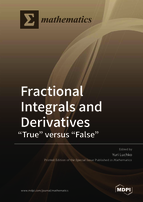Fractional Integrals and Derivatives: “True” versus “False”
A special issue of Mathematics (ISSN 2227-7390). This special issue belongs to the section "Computational and Applied Mathematics".
Deadline for manuscript submissions: closed (30 September 2020) | Viewed by 47135
Special Issue Editor
Interests: fractional calculus; ordinary and partial fractional differential equations; mathematical modelling with fractional calculus models; fractional anomalous diffusion and wave propagation; integral transforms and special functions in fractional calculus
Special Issues, Collections and Topics in MDPI journals
Special Issue Information
Dear Colleagues,
This Special Issue is devoted to some serious problems regarding the current development of Fractional Calculus (FC).
Even if FC is nearly as old as the conventional calculus, for long time it was addressed and used just sporadically and only by few scientists. Within the last few decades, the situation changed dramatically and nowadays we observe an exponential growth of FC publications, conferences, and scientists involved in this topic. One of the explanations for this phenomenon is in active attempts to introduce a new kind of mathematical models containing fractional order operators into physics, chemistry, engineering, biology, medicine, and other sciences. This speeds up the development of the mathematical theory of FC, including fractional ordinary and partial differential equations, fractional calculus of variations, inverse problems for fractional differential equations, fractional stochastic models, etc. Unfortunately, some of these new models and results are just formal “fractionalisations” of the known conventional theories, often without any justification and motivation.
Additionally, a recent trend in FC is in introducing “new fractional derivatives and integrals” and considering classical equations and models with these fractional order operators instead of conventional integrals and derivatives. This development led to an uncontrolled flood of FC publications both in mathematical and physical journals. Some of these publications contain trivial, well-known, and sometimes even wrong results that threaten the image of FC in scientific community. Thus, we have to think about and to answer questions like “What are the fractional integrals and derivatives?”, “What are their decisive mathematical properties?”, “What fractional operators make sense in applications and why?’’, etc. These and similar questions have remained mostly unanswered until now.
The aim of this Special Issue is to provide an independent platform for discussing these essential problems in the current development of FC. Contributions devoted both to the “new fractional integrals and derivatives” and their justification and those containing constructive criticism of these concepts are welcome.
Guest Editor
Manuscript Submission Information
Manuscripts should be submitted online at www.mdpi.com by registering and logging in to this website. Once you are registered, click here to go to the submission form. Manuscripts can be submitted until the deadline. All submissions that pass pre-check are peer-reviewed. Accepted papers will be published continuously in the journal (as soon as accepted) and will be listed together on the special issue website. Research articles, review articles as well as short communications are invited. For planned papers, a title and short abstract (about 100 words) can be sent to the Editorial Office for announcement on this website.
Submitted manuscripts should not have been published previously, nor be under consideration for publication elsewhere (except conference proceedings papers). All manuscripts are thoroughly refereed through a single-blind peer-review process. A guide for authors and other relevant information for submission of manuscripts is available on the Instructions for Authors page. Mathematics is an international peer-reviewed open access semimonthly journal published by MDPI.
Please visit the Instructions for Authors page before submitting a manuscript. The Article Processing Charge (APC) for publication in this open access journal is 2600 CHF (Swiss Francs). Submitted papers should be well formatted and use good English. Authors may use MDPI's English editing service prior to publication or during author revisions.
Keywords
- fractional integrals and derivatives
- fractional differential equations
- mathematical properties of fractional operators
- applications of fractional integrals and derivatives
- physical justification of fractional operators
- modeling with fractional operators






